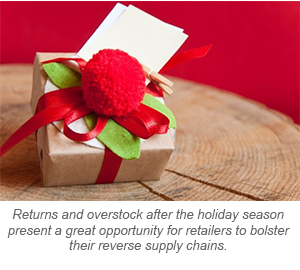No matter the time of year, returns are a significant issue for retailers. But in the weeks following the frenzy of the holiday shopping season, managing the high volume of returns can be challenging for retailers to manage alone. Most retailers have invested significantly in their supply chains, but few have devoted the same resources to their reverse supply chains, which are critical for adequately handling returns in a way that maximizes recovery and velocity.
This article will outline three key strategies to help retailers build out a robust reverse supply chain that will help them turn the burden of returned goods into recovery to fuel core business.
 1. Create a High-Performance Reverse Supply Chain
1. Create a High-Performance Reverse Supply Chain
Most retailers cut costs by improving the efficiency of their supply chains, but very few invest in processes that help them manage goods that come back to them after they’ve reached the consumer or sat unsold on store shelves. Yet there are considerable opportunities for cost savings in the reverse supply chain, which is where overstock and returns are managed.
Retailers can maximize the efficiency and velocity of the returns process through accessible distribution centers equipped with world-class warehouse management systems and data analytics to measure results. They can also drive higher recovery for returned goods by using recommerce strategies to reach and influence buyers interested in great deals on returned goods, thus ensuring maximum recovery.
Working with a dedicated reverse supply chain partner allows retailers to access these benefits while staying focused on their core competencies.
2. Protect the Brand in Secondary Markets
Secondary markets can be fraught with risk. A retailer’s brand can be negatively impacted if it fails to adhere to data protection laws when reselling used goods. Further, it’s important to vet each potential buyer to make sure it isn’t associated with illicit activities. The retailer must also ensure the quality of every product sold through secondary markets. Working with a reverse supply chain (RSC) partner is a way to minimize the risks that come with selling surplus inventory.
It’s also critical to create a great customer experience in secondary marketplaces. Being able to “wow” customers through superior customer service – even in secondary markets – will further enhance brand image. A RSC partner will provide white-labeled experiences – on their ecommerce site or your own – to optimize brand experiences for surplus goods. This includes offering:
- Detailed information and photos on all surplus for sale
- Friendly, responsive customer service
- Fast shipping
- An easy-to-use website
3. Focus on a Sustainable Process
Green business has really caught on with companies in all industries, and the reverse supply chain provides ample opportunity to flesh out existing sustainability initiatives or create new ones. Unfortunately, the return-to-vendor (RTV) process often hinders efforts to improve sustainability due to landfill disposal protocols. In addition to being environmentally unfriendly, this practice includes expensive landfill fees on top of lost profits.
3. Focus on a Sustainable Process
Green business has really caught on with companies in all industries, and the reverse supply chain provides ample opportunity to flesh out existing sustainability initiatives or create new ones. Unfortunately, the return-to-vendor (RTV) process often hinders efforts to improve sustainability due to landfill disposal protocols. In addition to being environmentally unfriendly, this practice includes expensive landfill fees on top of lost profits.
An RSC provider works with retailers and vendors to create a mutually beneficial RTV program that meets the vendor’s brand goals and requirements while maximizing recovery and velocity. With an experienced RSC provider, retailers can boost sustainability metrics for the entire company by following the “R” Cycle in returns management: reuse, refurbish, recommerce, redistribute, and recycle. This will give products a second life and ultimately defer them from a landfill.
Case Study: Managing an Efficient Return-to-Vendor Process for a Large Outdoor Retailer
In 2010, one of the largest outdoor retailers in the world was looking for an RSC partner to manage its RTV policy. Liquidity Services received all returned goods from the retailer into one of its warehouses and unloaded, sorted, and stored shipments of goods.
Based on the agreement for each product, the warehouse team designated each product to be either shipped back to the vendor, liquidated in the secondary market through our multichannel marketing approach (including via our online marketplaces), or destroyed through an environmentally friendly recycling process. Liquidity Services handled the end-to-end process of returned goods from over 120 of the client’s stores, greatly exceeding the retailer’s recovery goals.
The reverse supply chain provides opportunity for retailers and consumer brands to create competitive advantage and produce results that support larger strategic goals, whether those are streamlining the supply chain, improving brand perception, or enhancing sustainability initiatives. With the right process and partner, retailers can increase recovery and cut costs, while addressing risks in the new retail supply chain with winning strategies.




Comments are closed.